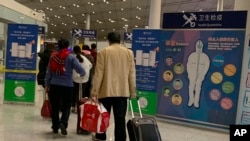A second U.S. patient with the new coronavirus was identified Friday, according to health officials.
The Chicago, Illinois woman returned January 13 from Wuhan, China showing no signs of the acute respiratory illness, but called her doctor several days later to say she felt sick. Wuhan, the capital of central China's Hubei province, is where the deadly outbreak is believed to have started.
The woman, who is in her 60s, reportedly is doing well but hospitalized "primarily for infection control," said Dr. Allison Arwady, Chicago's public heath commissioner.
People who had close contact with the woman are being monitored.
The U.S. announced its first case Tuesday in the northwestern state of Washington. Health officials there said a man who returned to Seattle from Wuhan last week is hospitalized in good condition, but has pneumonia.
Medical authorities say it's likely additional cases will be identified in the near term because the virus apparently has a two-week incubation period.
The Centers for Disease Control and Prevention says more than 2,000 travelers returning to U.S. soil have been screened at U.S. airports, and 63 patients in 22 states were being tested. Of those being tested, 11 thus far have been found to be free of the virus.
The Chinese National Health Commission said Friday that there are 830 confirmed cases of the new coronavirus countrywide, while at least 41 people have died.
The Chinese government isolated more cities Friday, an unprecedented move to contain the coronavirus, which has spread to other countries.
At least 10 cities, and a total of at least 33 million people, have been put on lockdown – Wuhan, Huanggang, Ezhou, Chibi, Qianjiang, Zhijiang; Jingmen, Xiantao, Xiaogan and Huangshi – all in Hubei province, on the eve of the Lunar New Year, when millions of Chinese traditionally travel.
Shanghai Disney Resort announced on its website that it is temporarily closing Shanghai Disneyland, a major tourist attraction during Lunar New Year, “in response to the prevention and control of the disease outbreak and in order to ensure the health and safety” of guests and cast.
The municipality authorities of Wuhan said Friday that the city is building a new 1,000-bed hospital, expected to be completed by February 3.
Thursday authorities first banned planes and trains from leaving the city of Wuhan. Toll roads were closed, and ferry, subway and bus services were also suspended.
Wuhan authorities have demanded that all residents wear masks in public and urged government and private sector employees to wear them in the workplace, according to the Xinhua news agency, which cited a government official.
Similar measures were taken hours later in the nearby cities of Huanggang and Ezhou.
The government also canceled holiday events in Beijing that usually attract large crowds.
Fifteen medical workers are among those who have been infected by the virus, which has spread from Wuhan to Beijing, Shanghai and Guangdong province, as well as Japan, South Korea, Thailand, Taiwan and the United States.
The World Health Organization said Thursday the deadly virus has not yet developed into a worldwide health emergency.“
This is an emergency in China, but it has not yet become a global health emergency,” WHO Director-General Tedros Adhanom Ghebreyesus said after a two-day emergency meeting in Geneva.
The U.N. health agency’s decision came after it received information from independent experts who spent two days assessing details about the spread of the new coronavirus.
WHO considers an international emergency an “extraordinary event” that puts other countries at risk and one that requires a coordinated global response.
U.S. President Donald Trump assured reporters during a press conference in Davos, Switzerland, Wednesday that U.S. officials "have a plan" to deal with the new outbreak, praising experts at the Centers for Disease Control and Prevention as "terrific, very great professionals, and we're in great shape."
Airports around the world have begun screening travelers from Wuhan for any detection of the virus.
A coronavirus is one of a large family of viruses that can cause illnesses ranging from the common cold to the deadly SARS.











